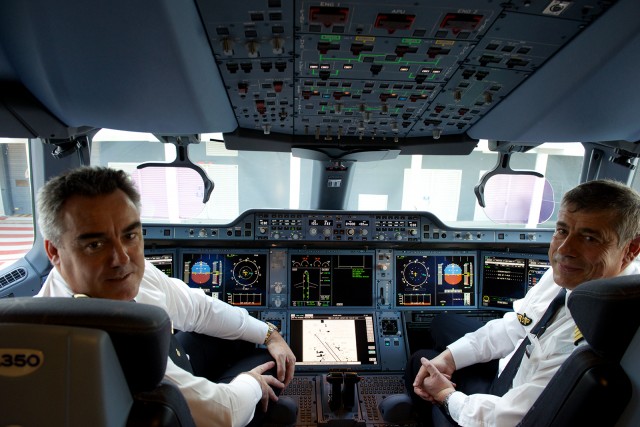
The A350 flight deck being shown off by its joyful flight crew – Photo: Bernie Leighton | AirlineReporter
For press, the delivery ceremony completion usually means it is either time to drive back home, or return to the hotel and pack for the flight.
Not this day.
Airbus and Qatar Airways decided that it would be a great way to enhance the press experience if everyone was given a demonstration flight aboard the Airbus A350.
This was a great idea, so there had to be some kind of drawback! For a demonstration flight that would last an hour with pre-selected passengers, all 200 of us present had to go through security screening. A process that felt like it took longer than the flight itself. What a surprise, no one had any contraband or ill intent!
Rant aside, after what felt like an eternity, I finally made it onto the jet bridge to a crowd that was more akin to being in the last row of economy on a domestic narrowbody. I realized then and there that taking any kind of photographic imagery was going to be a challenge.
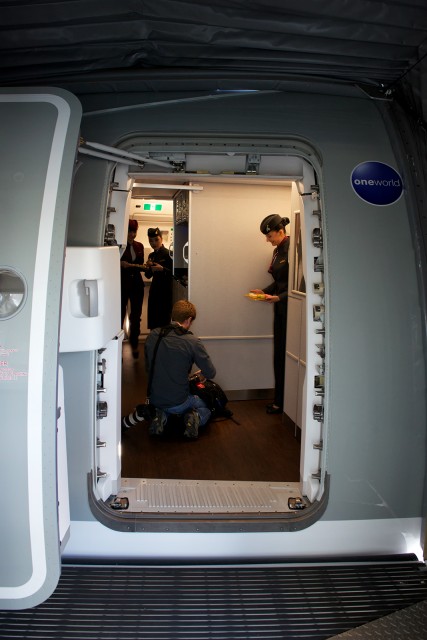
Door L1 on Qatar Airways’ first A350 XWB, long after the crowd had dispersed for lunch Photo: Bernie Leighton | AirlineReporter
We boarded via a choice of either L1 or L2, I chose L2 as I wanted to see the lovely dome light and the in-flight bar. The doors themselves do not create any temporary feelings of claustrophobia. In the case of L2, you immediately walk into a spacious and open atrium. The ceiling is higher than one has come to expect on regular passenger aircraft, the walls more vertical.
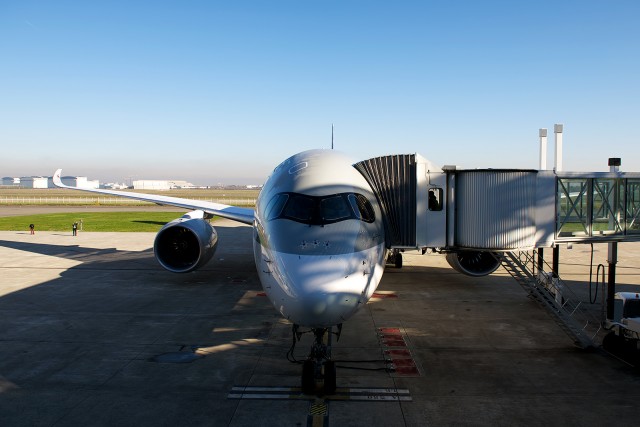
Qatar Airways’ First A350 (MSN006) at the Airbus Delivery Center – Photo: Bernie Leighton | AirlineReporter
Qatar Airways, to much fanfare, took delivery today of the first commercial A350-900. Not only is this the first serial production A350 to be delivered to a customer, it is also the first of 80 A350s headed for Qatar Airways. Qatar has 36 additional -900s on order as well as 43 -1000s.
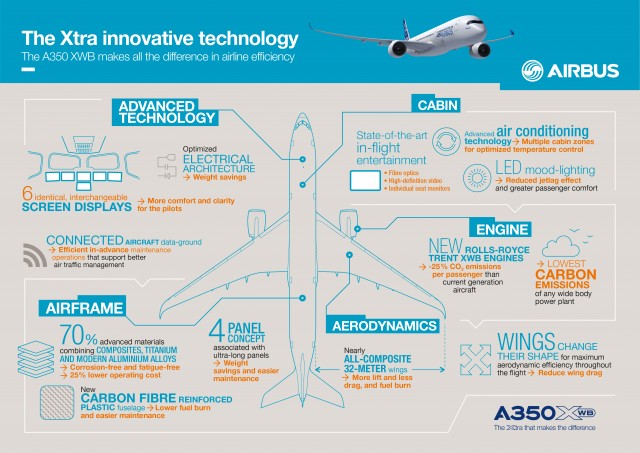
An easy way to understand the technology in the A350 – Image: Airbus
The A350 itself represents a technological leap for Airbus, as it is their first aircraft to be over 50% composite materials; 53%, technically – including the longest manufactured single pieces of carbon fiber that make up the wing assembly. The remainder of the aircraft is made up of modern metallurgical feats that manifest themselves as lighter titanium and aluminum alloys.
BONUS: OMG YES! Photos & Video of Five Airbus A350s Flying in Formation
If that wasn’t enough to impress you, the A350 is the first aircraft certified by the EASA to operate ETOPS 370 missions prior to entry-into-service (EIS). ETOPS 370 is the next phase of Extended-range Twin Operations, allowing an aircraft to be certified to fly on one engine for more than six hours. This opens up a whole host of new destinations for twin-engine aircraft, as well as adds efficiencies to existing air routes as airlines will no longer have to “hug” strategic alternate airports as tightly.
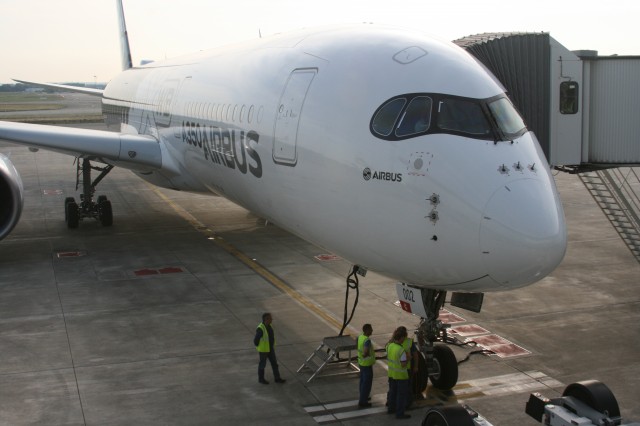
The Airbus A350 (MSN002) waiting to be boarded – Photo: Owen Zupp
A flight test program is a finely-tuned schedule, down to the most detailed demonstration, with every minute of flight time accounted for. The deadlines of certification and delivery loom ever-closer as the engineers and pilots continue to put the aircraft through its paces. Still, recently, Airbus was able to somehow wedge a 60-minute flight into their A350 XWB timeline to showcase their newest family member to a media contingent visiting Toulouse for their ‘Airbus Innovations 2014’. I was fortunate to be one of those that flew aboard that flight.
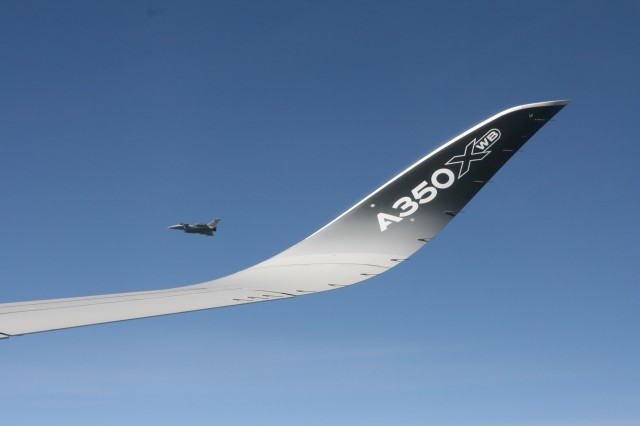
The A350 wingtip with special escort – Photo: Owen Zupp
The fact that Airbus was prepared to conduct the flight reflects two rather key points. Firstly, that their flight test program is on track and secondly, that they are confident enough in their product to take a load of media scribes aloft. Furthermore, Airbus created specific social media channels for the journalists to share the flight with the world. Consequently, there was a buzz of texting and tweeting as 200 passengers cleared a security channel and filed down the aero-bridge.
The aircraft’s cabin was still in flight test mode, so interspersed amongst the passenger seats were stations of data-gathering equipment, computer screens, and cables taped to the floor. Even so, as one walked through business class and into the economy cabin, there was still that new airplane smell. The interior boasted all of the mod-cons of inflight entertainment systems and even the fasten belt sign was a scrolling digital display. As we all settled in, there was no mistaking that this was a new generation of passenger jet and we were very privileged to take flight.
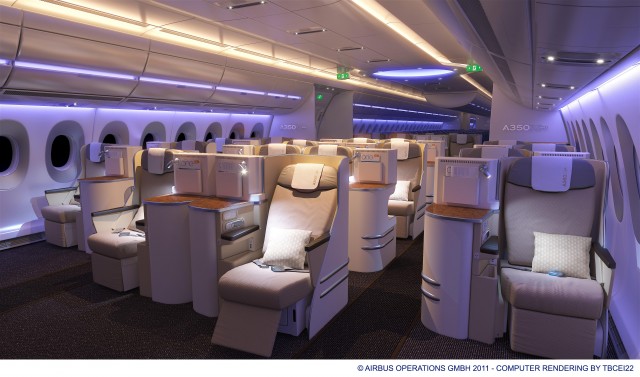
The A350 XWB cabin design ’“ with its smooth curves, flowing lines, innovative lighting, and wide windows ’“ helps create a pleasant and soothing atmosphere for business class travellers – Photo: Airbus
Recently in Germany, Airbus showed off a potential interior for their new Airbus A350 XWB. They shared the second test aircraft, MSN002 with a partial test interior and mock cabin. Even though it looks impressive, at the end of the day, airline customers will be the ones deciding what finishes will go into the aircraft.
Although Airbus decided to show off a 3-3-3 layout in economy, the aircraft could end up seeing a ten-abreast configuration in the future.
Although the interior of MSN002 gives us a preview, Airbus is planning to fit MSN005 with a full interior which might show more of the robust ideas, like a impressive entry way.
Continue reading to see photos of the interior and descriptions from Airbus…
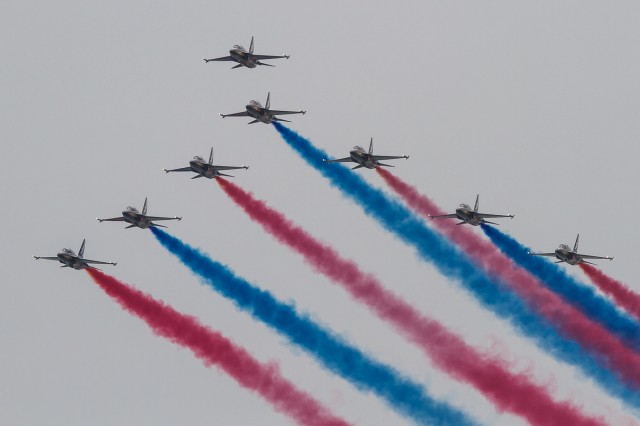
Korean Air Force Black Eagles aerobatic display team opening the show with a magnificent fly-by Photo: Jacob Pfleger | AirlineReporter
This was my first visit to the Singapore Airshow which is Asia’s largest bi-annual aviation event and has been running since 2008. My expectations of the show were pretty high given that Singapore is a world-wide leader within the aviation industry.
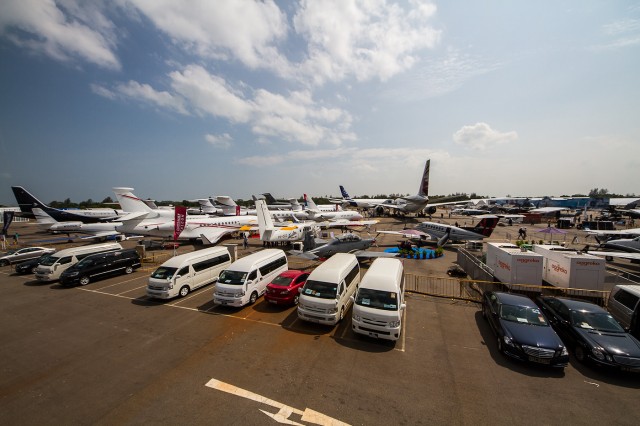
The static display was just as impressive as the flying display – Photo: Jacob Pfleger | AirlineReporter
The event ran for six days, with the first four being reserved for trade visitors.
The flying display was limited to one hour during each day of the trade show. This is because when the display takes place, all arrivals and departures at Singapore Changi airport must be suspended due to the proximity of the display site to the approach/departure tracks of the airport.This restriction also meant that the display had to take place outside of peak hours, so it happened during the middle of the day. As such, the lighting conditions proved very challenging for photography and general viewing of some aerobatic displays.
At present, there is a strong possibility that the 2016 show’s display will be cut even further, to just 30 minutes, but with more than one display window during the day.








